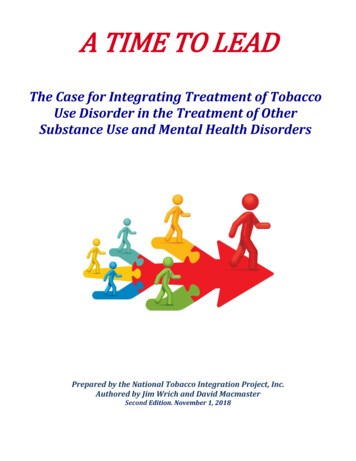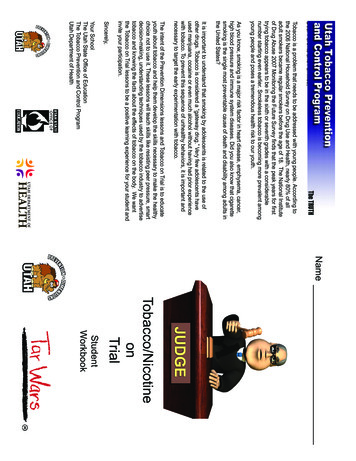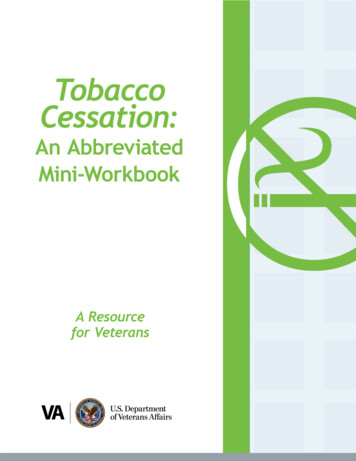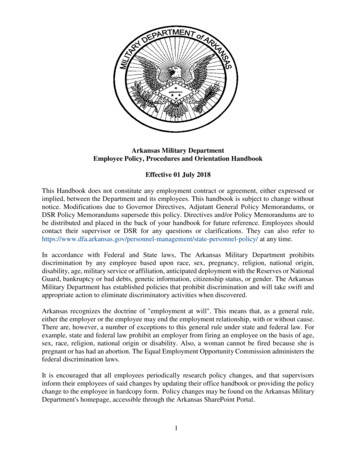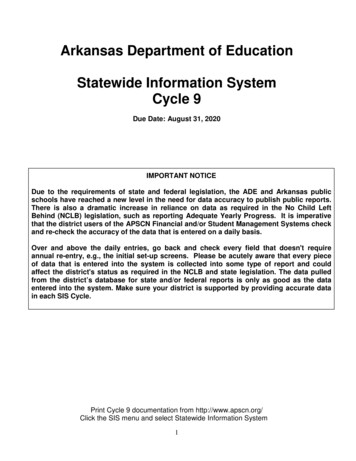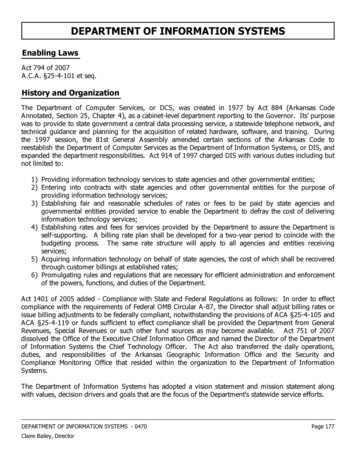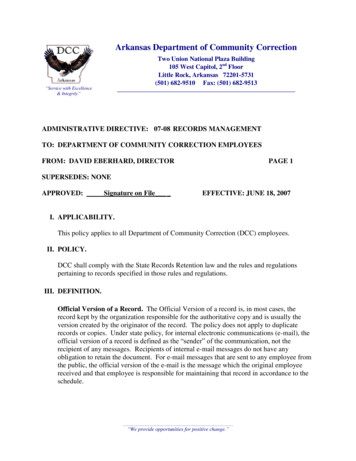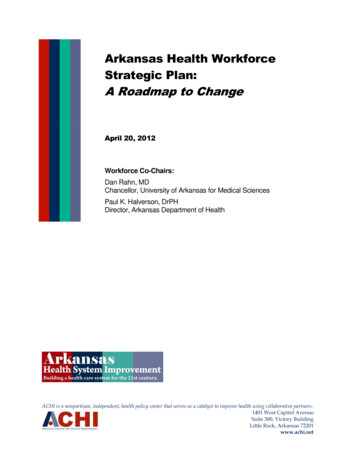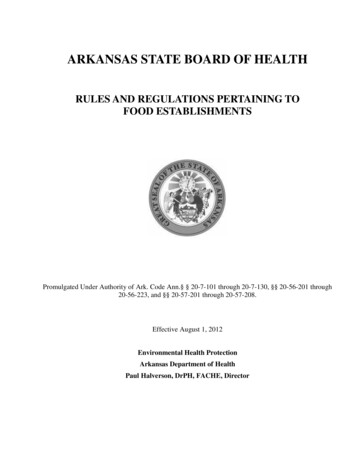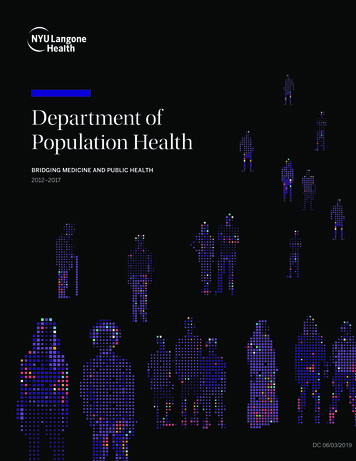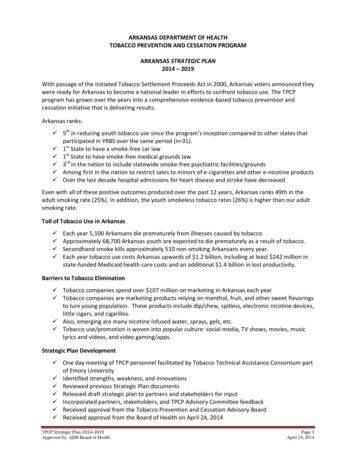
Transcription
ARKANSAS DEPARTMENT OF HEALTHTOBACCO PREVENTION AND CESSATION PROGRAMARKANSAS STRATEGIC PLAN2014 – 2019With passage of the Initiated Tobacco Settlement Proceeds Act in 2000, Arkansas voters announced theywere ready for Arkansas to become a national leader in efforts to confront tobacco use. The TPCPprogram has grown over the years into a comprehensive evidence-based tobacco prevention andcessation initiative that is delivering results.Arkansas ranks: 5th in reducing youth tobacco use since the program’s inception compared to other states thatparticipated in YRBS over the same period (n 31). 1st State to have a smoke-free car law 1st State to have smoke-free medical grounds law 3rd in the nation to include statewide smoke-free psychiatric facilities/grounds Among first in the nation to restrict sales to minors of e-cigarettes and other e-nicotine products Over the last decade hospital admissions for heart disease and stroke have decreasedEven with all of these positive outcomes produced over the past 12 years, Arkansas ranks 49th in theadult smoking rate (25%). In addition, the youth smokeless tobacco rates (26%) is higher than our adultsmoking rate.Toll of Tobacco Use in Arkansas Each year 5,100 Arkansans die prematurely from illnesses caused by tobacco.Approximately 68,700 Arkansas youth are expected to die prematurely as a result of tobacco.Secondhand smoke kills approximately 510 non-smoking Arkansans every year.Each year tobacco use costs Arkansas upwards of 1.2 billion, including at least 242 million instate-funded Medicaid health care costs and an additional 1.4 billion in lost productivity.Barriers to Tobacco Elimination Tobacco companies spend over 107 million on marketing in Arkansas each year Tobacco companies are marketing products relying on menthol, fruit, and other sweet flavoringsto lure young population. These products include dip/chew, spitless, electronic nicotine devices,little cigars, and cigarillos. Also, emerging are many nicotine infused water, sprays, gels, etc. Tobacco use/promotion is woven into popular culture: social media, TV shows, movies, musiclyrics and videos, and video gaming/apps.Strategic Plan Development One day meeting of TPCP personnel facilitated by Tobacco Technical Assistance Consortium partof Emory University Identified strengths, weakness, and innovations Reviewed previous Strategic Plan documents Released draft strategic plan to partners and stakeholders for input Incorporated partners, stakeholders, and TPCP Advisory Committee feedback Received approval from the Tobacco Prevention and Cessation Advisory Board Received approval from the Board of Health on April 24, 2014TPCP Strategic Plan 2014-2019Approved by: ADH Board of HealthPage 1April 24, 2014
Overarching Principles To save livesDiminish sufferingCut health-related and economic costsConserve public and private dollarsTPCP CommitmentUse evidence-based interventions while developing promising practices to address the use of productscontaining, made, or derived from tobacco, including but not limited to cigarette, cigar, pipe, smokeless,dip, chew, snus, snuff, e-cigarette, other tobacco products (OTP), and electronic nicotine devices (ENDS).Develop and strengthen partnerships throughout ArkansasIdentify and eliminate tobacco-related disparities among population groups throughout all aspects ofservice deliveryRapidly assess and develop counter-media programs for new tobacco/ENDS products and youth focusedmarketingUse population-based approaches as identified by the CDC Best Practices Model State and Community InterventionsMass-Reach Health Communication InterventionsCessation InterventionSurveillance and EvaluationInfrastructure, Administration, and ManagementUtilize best practices goal areas for comprehensive tobacco control programs which include multipleaction steps and a host of partners and stakeholders Prevent Initiation of Tobacco/Nicotine Use Among Youth and Young Adults (0-26 years)Eliminate Exposure to Secondhand and Third-hand SmokePromote Quitting Among Adults and YouthProgram EvaluationGOAL I: PREVENT INITIATION OF NICOTINE USE AMONG YOUTH AND YOUNG ADULTS (0-26 YEARS)OBJECTIVE: Increase barriers to youth and young adult access to tobacco/ENDS products and promotetobacco abstinenceBASELINE: Synar/Retailer Compliance Checks, YRBS, APNA, Participation Reports, and School-basedTobacco Violations through ADE.STRATEGIES: Activate TPCP leadership to increase partnerships with state agencies, institutions and nonprofits to create systems change to include the integration of tobacco prevention and secondaryintervention among youth and young adultsDevelop multi-media communications with media partners to discourage initiation to also include prepregnancyCollaborate with media partners and sub-grantees will de-normalize tobacco/ENDS use througheducational and interactive projects at the local and state levelTPCP Strategic Plan 2014-2019Approved by: ADH Board of HealthPage 2April 24, 2014
Collaborate with Arkansas Department of Education (ADE), Arkansas School Board Association, privateschools and sub-grantees to secure commitment to implement all components of the ArkansasAcademic-Based Practice Guidelines for Effective Tobacco ControlCollaborate with community partners to increase taxes on all tobacco/ENDS derived productsDevelop 24/7 evidence-based tobacco advocacy, interactive education, and prevention website to alsoinclude opportunities to engage in tobacco prevention projects/eventsCollaborate with Arkansas Tobacco Control to educate and monitor tobacco retailers to reduce illegalsalesEngage internal and external legal resources for policy developmentActively engage youth to promote tobacco abstinence through sub-grantee and Statewide youthcoalitionIntegrate efforts to eliminate tobacco related disparities among youth and young adultsOUTCOMES: 1. Decrease tobacco sales to undercover minors to less than 4%; 2. Decrease in youth andyoung adults reporting tobacco use (YRBS, APNA); 3. Increase participation of youth and young adults innicotine/tobacco advocacy and activities; and 4. Decrease in tobacco policy violations at all publicschools.GOAL II: ELIMINATE EXPOSURE TO SECONDHAND AND THIRD-HAND SMOKEOBJECTIVE: Increase the number of Arkansans who report living, working and playing in a smoke-free andvapor-free environments.BASELINE: NATS & BRFSS, TPCP Database – Smoke/Tobacco-free Parks and BusinessesSTRATEGIES: Collaborate with community partners to protect and strengthen smoke-free polices at thelocal and state level including, but not limited to parks, pathways, patio dining, vapor and hookah bars,bars, casinos, etc.Secure development and enforcement of comprehensive ENDS/tobacco-free policies including, but notlimited to worksite campus, pathways, multiunit housing, etc.Support the development of tobacco-free hiring policiesIncrease the voluntary adoption of personal smoke-free cars and homes, which includes ENDS, amongArkansansIntegrate efforts to eliminate secondhand and third-hand smoke related disparities among ArkansansOUTCOMES: Increase percent of Arkansans who report living, working or playing in a smoke-freeenvironmentGOAL III: PROMOTE QUITTING AMONG ADULTS AND YOUTHOBJECTIVE 1: Reduce tobacco/ENDS use and associated disease burden by creating systems change toincorporate Clinical Practice Guidelines for Treating Tobacco Use and DependenceBASELINE: Physician Survey, Number of MOA’s, Alere and STOP reports, and State Morbidity DataTPCP Strategic Plan 2014-2019Approved by: ADH Board of HealthPage 3April 24, 2014
STRATEGIES: Integration of standardized evidence-based cessation curricula at all colleges anduniversities including medical, nursing, dental, mental health, substance abuse and allied healthprograms to address tobacco/ENDS useIntegrate Clinical Practice Guidelines for Treating Tobacco Use And Dependence (5A’s/2A’s & R) at allexisting medical, dental, mental health, and substance abuse facilities (including LPH) STOP Outreach,State and Community Grantees, Medicaid, AFMC, Associations (AMA, Hospital, AMDPA, Pharmacy,Nursing, Dental Hygienists, etc.)Integration of Clinical Practice Guidelines for Treating Tobacco Use And Dependence through all federaland state supported agencies and institutions to include disparate populationsIncrease the number of practitioners who have received accredited training on tobacco treatment usingnational expertsExpand reach and capacity for tobacco/ENDS cessation treatment by training through promoting the useof www.arstop.orgPromote expansion of insurance coverage and utilization of proven tobacco/ENDS cessation treatmentsto the benefit level defined in the Federal Employees Health Benefits ProgramOBJECTIVE 2: Promote quitting nicotine and other tobacco related products including smokeless productsthrough multi-media communicationsBASELINE: Alere Reports and Media Recall Survey, number of trainings and attendanceSTRATEGIES: Collaborate with ADH Communications and media partners to utilize both paid and earnedmedia sources including social media to educate and inform the general, disparate and minoritypopulations regarding the harms of tobacco/ENDS use including smokeless products and available quitservicesIncrease partnerships with other state agencies, institutions, and non-profits to create systems changeto include the integration of tobacco/ENDS cessationIncrease utilization of the Arkansas Tobacco Quitline and its services including individual(age/ethnicity/special populations) confidential phone/web-based counseling, pharmacotherapy(patches, gum, lozenges, varenicline), and written resource materialsIntegrate efforts to eliminate smokeless tobacco related disparities among youth and adultsOUTCOMES: 1. Document increased use of Clinical Practice Guidelines for Treating Tobacco Use andDependence; 2. Reach of ATQ will increase from 3% to a minimum of 5% of all nicotine users; 3.Reduction of health related incidences (MI, Diabetes, Respiratory Illness, Stroke, Cancer, & etc.); and 4.Reach of ATQ will increase in all groups of nicotine users including smokeless products.GOAL IV – PROGRAM EVALUATIONOBJECTIVE: Evaluate program activitiesBASELINE: TBDSTRATEGIES: Collaborate with ADH Epidemiology, Arkansas Foundation for Medical Care, and COPH,UALR – Survey Research Center and external partners to document financial value of program activitiesand outcomesTPCP Strategic Plan 2014-2019Approved by: ADH Board of HealthPage 4April 24, 2014
Collaborate with ADH Epidemiology to document decrease in disease incidences as a result of SHSexposure, including but not limited to, MI, Cancer, Respiratory Illness, Stroke and mortality etc.Collaborate with identified contractor, implement survey tool designed to measure “quits” achievedthrough methods other than the Arkansas Tobacco QuitlineUtilize data and evaluation findings to drive program efforts and implementation of interventions.OUTCOMES: 1. Determine return-on-investment of TPCP effortsTPCP Strategic Plan 2014-2019Approved by: ADH Board of HealthPage 5April 24, 2014
universities including medical, nursing, dental, mental health, substance abuse and allied health programs to address tobacco/ENDS use Integrate Clinical Practice Guidelines for Treating Tobacco Use And Dependence (5A’s/2A’s & R) at all existing medical, dental, mental health, and substance abuse facilities (including LPH) STOP Outreach,
